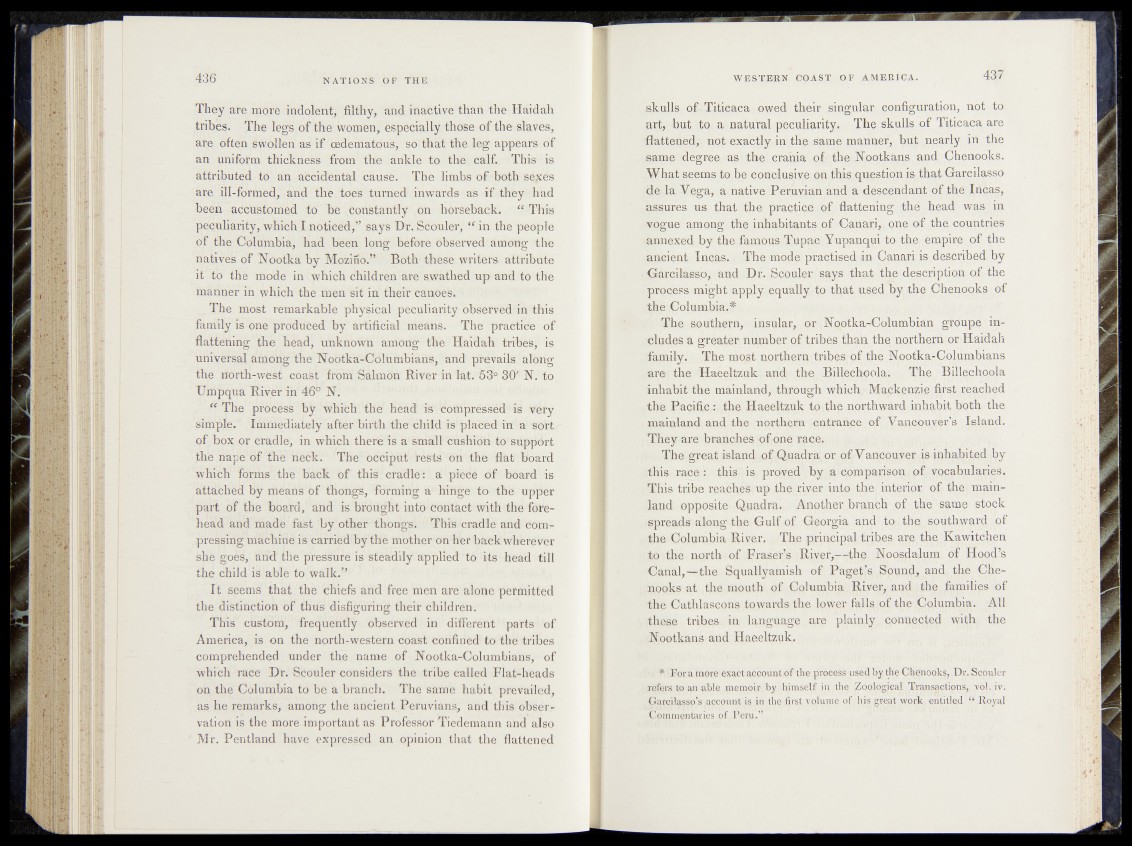
They are niore indolent, filthy, afid inactive than the' Haidah
tribes. The‘legs of the women; especially those of thenslaves,
are often swollen as if oedematous,-:so‘that the teg appears 6f
an uniform thickness from the ankle to the calf.. This is
attributed to an accidental caused The limbs of tooth se^és
are ill-formed, and tlietoes ' tümed inwards as if they had
been accüstoméd to be Constantly . on h orseback. “ This
peculiar!ty> which l noticed,” says Dr. Seouler, “ in the people
of the Columbia, had been long before observed among 'the
natives of Footka by Mozino.”: Both these writers1 attribute
it tó thé mode in . which children afefswathed up and to - toe
manner in which the mén sit in their cancfeW^ -
The most remarkable physical peculiarity o l^%ëd)iàftôis
family is one produced by artificial 'naëâiis. The practice of
flattening the head, unknown among : the Ilaidah t r i b u i s
iiniyersal àinôhg the Footka-Columbikns, and prevailstelörig
the tforth-wèst coast from Sàlmon River in lat.5*S° 3 # F . t o e
Umpqua River in 46° F .
“ The prôcësS! by Whictr.Tbêr héàd d^lSomprësièd*® ^ÿ y
simple. Immediately after birth plàèM'ihfaîtëêikt,
of box or cradle, in which there is a small ^feWdn tö :Mpp4rt
the nape of the neck. The' oCcipüteVêSts’ten thé fiai Woard
which forms the back of this cradle: a ‘pfedé of’-board1 fe
attached by means of thorigs, forming à hiögë ih'Sthë ripper
part of the board, and is brought into; contact with * the-fofe-
héad 'and made fast by other thongs: •: Thte. cradlé* and Côto^
pressing machine is carried by the mother ön h'er back wherever
she goès, and tile pressure is steadily applied ’to its head till
the child is able to walk.”
I t ’ seems that the Chiefs and free men are alone permitted
the distinction of thus disfiguring their children.
This custom, frequently observed in different parts of
America, is on the north-western coast confined to the tribes
comprehended under the name of Footka-Columbians, of
which race Dr. Scoüler considers the tribe called Flat-heads
on the Columbia to be à branch. ' The same habit prevailed,
as he remarks, among the ancient. Peruvians, and this obser-
. vation is the more-important as Professor Tiedemann and also
* Mr. Pentland have expressed an opinion that the flattened
skulls; of.Titicaca owed their ^singular configuration, not to
art, hut -to, ,a natural peculiarity. The skulls of T|ticaea are
flattened, not exactly in the, same manner, but .nearly in the
.same degree--as - th ^ crania ofythe.Fpotkans and Chenooks.
.What seems tp;be1eoqcIusiy:e,qn this^qupstipn is that Gqrgilasso
fle-la^Tpga, a native Peruvian and a descendant of the Incas,
assures us that the practice;,of flattening .thehead was in
-YPgue among; thp^ip^bitants of-f}a-nari^ one of^ tod-countries
annexed by-the famous T.up^p.yijpanqui to th,e empire of the
ancient- Incas. The mode practised -in Canari is described by
Garcilasso, apd Dr, Scpuler says that the description of the
process-might apply equally to thati(usedny^the Chenooks of
.the rColumbia.#
The southern, insular,, o r, F,Optka-Columbian groupe includes
a greater* number of tribes than the northern or Haidah
Tiddly. The most northern 'tribes of the J^potka-Gplumbians
are the Haeeltzuk and? tt^<q( .Bille.choolai..^. The Billechopla
inhabit the mainland, through which Mackenzi.e first, reached
.the Pacific.:,-.the Haeeltzuk tp;thpmqr|h^ard ipha,bit both the.
mainland and the northern entrance of ^^ep u y er’s . Island.
They are branches pfpne race.';f-,
The great island ,ofsQiiadra' or qf, Vancouy'ernis inhabited by
-.this race: this is proved .by a comparison ipfyocahplaries.
Tliis tri%e reaphesiup the.riyer into thei.inf^riqr of the; vpa.in—
•land opposite Quadra. Another,!)ranch of toe-same stock
.Spreads ateng the;Gulf of Georgia apd tovthp ,southward of
-.thp-Golumbia-Rivpr,,, The principal tribes. ^rp^hp Kawitchen
to the -north-of Fraser’s River,--—tog,JSppsdaJum of Hoqd’s
©anal,—the Squallyamish of Page^^Qppdl;an|h Qhe-
, Hooks at the mo uth of. ;Qplu mbi a Riyqr^ anxf| th e | fiamili es o f
tog Cathlascpn^ .towards the lp^er falls ,Qf top jjj^umbia. All
these tribes in- language, are plainly.^ponnpg^._ with the
Footkansiand Haeeltzuk. j
t * Foi’a teOr® eststctftfeounl of th® process uset|hy,&e C^qnooks, Dr.SScpukr
jtpfprs tQ.anaWeijWeiHojr by himself jp th$ ^qploffipl. Transactions,, vol%iv.
,Gaplasso’s.apeoupt is in the4rs,t yoiurnei-ofjhis great work entitled “.Royal
Commentaries of Peru.”